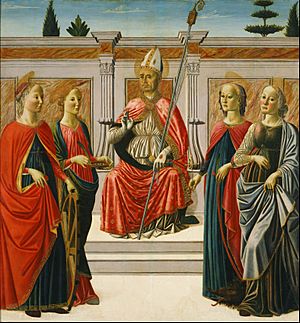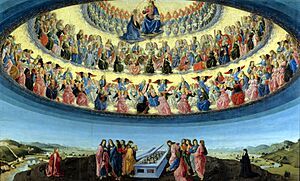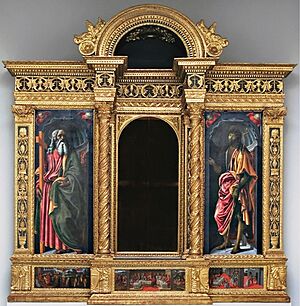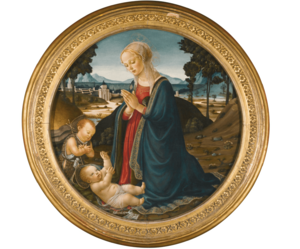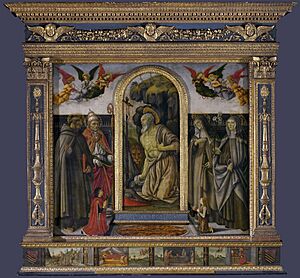Francesco Botticini facts for kids
Francesco Botticini (born Francesco di Giovanni, 1446 – 16 January 1498) was a talented Italian painter. He lived during the exciting time of the Early Renaissance. Francesco was born in Florence, Italy, and worked there his whole life until he passed away in 1498. We don't have many official records of his paintings. But art experts believe he created many beautiful works. These include large paintings for churches (called altarpieces), smaller religious pictures, and some portraits.
Contents
Life of Francesco Botticini
Early Years and Training
Francesco Botticini was born in Florence in 1446. His father, Giovanni di Domenico di Piero, painted playing cards. Francesco likely learned to paint from his father first.
By 1459, when he was about 13, Francesco worked as an assistant. He joined the art workshop of Neri di Bicci. A workshop was like a studio and school where artists learned and worked together. He left Neri's workshop in 1460.
Later, Botticini probably worked with Andrea del Verrocchio. Verrocchio's workshop was very famous. There, Francesco might have met other future art stars. These included Leonardo da Vinci, Lorenzo di Credi, Domenico Ghirlandaio, and Pietro Perugino. Even though there are no records, experts think he was there because of his painting style.
By 1469, Botticini had opened his own workshop. His father helped him with work contracts until 1475. Francesco officially became independent in 1477.
First Important Paintings
Some of Botticini's first known paintings are from this time. They include Saint Nicholas and Four Female Saints. This painting is now in Tokyo, Japan. Another early work is Saint Sebastian in New York. He also painted a Madonna adoring the Child in Alabama.
His earliest dated painting is from 1471. It's an altarpiece called Madonna and Child with Saints. An altarpiece is a painting placed behind an altar in a church. This work shows a strong influence from Verrocchio. Also from around 1471 is Saint Monica Enthroned. This painting is in the Santo Spirito church in Florence. Another famous work from this period is Three Archangels with the Young Tobias at the Uffizi Gallery.
Developing His Own Style
By 1475, Botticini started to paint in his own unique way. His most famous painting, Assumption of the Virgin, shows this new style. This large painting is now in the National Gallery, London.
For a long time, people thought this painting was by Sandro Botticelli. But since the early 1900s, everyone agrees it's by Botticini. Records show the painting was started in 1475 and finished in 1477.
A poet named Matteo Palmieri and his wife ordered this painting. It was likely for their family chapel in a church in Florence. The painting shows a view of Florence and the Arno river valley. You can even see some of Palmieri's properties in the hills.
The painting shows Mary going up to heaven. Angels and saints welcome her. This idea came from Palmieri's poem, Città di Vita. This poem had some unusual ideas about souls. Because of these ideas, some people thought the painting was controversial. The faces of the people who ordered the painting were even scratched out later. This shows there were disagreements about Palmieri's beliefs.
In the 1480s, Botticini was very busy. He worked in Florence and nearby Empoli. For a church in Empoli, he made two large tabernacles. A tabernacle is a special container or structure for religious items. One was for Saint Sebastian, and the other for the Holy Sacrament. These are now in a museum. The Tabernacle of the Sacrament was ordered in 1486. It was mostly done by 1491. Botticini's son, Raffaello, finished it in 1504.
In 1488, Botticini painted an altarpiece called Pietà with Four Saints. This painting is now in Paris, France.
Botticini also painted many smaller religious pictures for homes. He was especially good at painting tondi. These are circular paintings. They often showed the Virgin Mary and the young Saint John the Baptist. Saint John was the patron saint of Florence. These paintings usually showed them adoring the Christ Child. One such painting was sold in London in 2013. Others are in museums in Florence, Paris, and Mexico City.
Later Works and Death
Botticini continued to paint important works in the 1490s. Around 1490, he painted Madonna and Child in Glory with Saints. This painting is now in the Louvre in Paris. In 1493, he painted another Madonna and Child with Two Angels and Saints. This one is in the Metropolitan Museum of Art in New York.
In the mid-1490s, he finished a very important altarpiece. It's called Saint Jerome with Saints and Angels. A rich family, the Rucellai, ordered it. This painting is now in the National Gallery in London. It shows Saint Jerome in the middle. He is surrounded by other saints and angels. The painting is special because Saint Jerome is shown in his own separate frame. It's like a picture within a picture! An art critic said it shows how art can move even holy people.
In 1495, Botticini painted Madonna and Child with Saint Francis, the Archangel Raphael and the Young Tobias. This work is now in Scotland.
Francesco Botticini died in Florence on January 16, 1498. He was 51 years old. His son, Raffaello Botticini, took over his workshop. Raffaello also became a well-known painter.
Posthumous Reputation
Francesco Botticini's art has continued to inspire people. In 1968, Esquire Magazine used one of his paintings for a famous cover. The cover showed the boxer Muhammad Ali. Ali posed like Botticini's painting of Saint Sebastian.
Saint Sebastian was a Christian saint who suffered greatly. Muhammad Ali was a famous boxer who faced challenges for his beliefs. The magazine cover wanted to show a connection between their struggles. Ali agreed to pose like the saint after studying Botticini's painting. The final image showed Ali with arrows, similar to how Saint Sebastian is often shown.
Images for kids
See also
 In Spanish: Francesco Botticini para niños
In Spanish: Francesco Botticini para niños


